Lacquered Brass Countertops & Backsplash: Pros and Cons You Should Know
Lacquered brass has gained attention in modern kitchens for its striking golden sheen and vintage-meets-contemporary charm. The lacquer coating provides a protective layer that slows down tarnishing and keeps the surface bright and polished for longer compared to raw brass. When used on countertops and backsplashes, this finish creates a bold design statement, offering both style and practicality. However, like any material, it carries strengths and drawbacks worth examining before committing to an installation.
Why consider lacquered brass over unlacquered brass?

While raw brass develops a natural patina over time, lacquered versions are designed to preserve the original golden look. Homeowners who love the shine without constant maintenance often choose lacquered surfaces. Understanding lacquered brass countertops and backsplash pros and cons helps you decide whether this finish suits your lifestyle and kitchen design. Compared to its unlacquered counterpart, lacquered brass offers less aging character but more surface protection.
What are the pros of lacquered brass countertops and backsplashes?
The advantages of lacquered brass extend beyond appearance. Here are the main benefits:
- Low Maintenance: The lacquer coating reduces the need for constant polishing.
- Long-Lasting Shine: Keeps its golden hue without quickly darkening.
- Durability: Resistant to stains, fingerprints, and water spots compared to bare brass.
- Hygienic Surface: Brass naturally resists bacteria, and lacquer enhances ease of cleaning.
- Bold Aesthetic: Adds a luxurious, high-end look that stands out in kitchens.
Additionally, lacquered brass pairs well with marble, quartz, or wood, creating a layered and stylish kitchen design. Resources like The Funky Kitchen often highlight how brass finishes can elevate an entire cooking space.
What are the cons of lacquered brass surfaces?
Despite its benefits, lacquered brass comes with challenges:
- Scratching Risk: The lacquer can chip or scratch, exposing raw brass underneath.
- Repair Difficulty: Once damaged, refinishing requires professional help.
- Heat Sensitivity: High heat may weaken or discolor the lacquer coating.
- Chemical Concerns: Harsh cleaners can strip the lacquer, leading to uneven wear.
- Less Natural Aging: If you prefer the patina look, lacquer prevents that natural charm.
According to Architectural Digest, finishes that resist tarnish often trade away the character that comes with aging metals, which some homeowners see as a disadvantage.
How do lacquered brass countertops perform in everyday use?
In daily cooking and cleaning, lacquered brass surfaces hold up well if treated with care. They resist water rings and food stains, making them practical in busy households. However, exposure to sharp utensils, hot pots, or abrasive sponges can damage the protective coating. Therefore, homeowners should use cutting boards, trivets, and gentle cleaning products to preserve the finish.
Are lacquered brass backsplashes practical?
Backsplashes in lacquered brass offer a glamorous touch while protecting walls from splashes. They are easier to maintain than countertops since they face less direct impact. Still, grease and steam from cooking can dull the finish if not cleaned regularly. Gentle wiping after each use is the best way to extend their life.
How do costs compare with other countertop materials?
Lacquered brass countertops are not the most budget-friendly option. The cost can be higher than laminate or tile, but similar to or slightly less than premium stones like marble or granite. The real value lies in their distinctive design impact and uniqueness. For homeowners seeking a statement kitchen, the price may be justified.
What design styles work best with lacquered brass?
These surfaces fit seamlessly into eclectic, modern, and industrial kitchens. They also pair beautifully with dark cabinetry, matte finishes, or natural wood for contrast. While trendy, lacquered brass can also feel timeless when used as an accent rather than a full-surface treatment.
Conclusion: Should you choose lacquered brass for your kitchen?
Lacquered brass countertops and backsplashes combine striking design with practical benefits, but they require mindful care. If you want lasting shine, easy cleaning, and a bold statement, lacquered brass is a great option. However, if you prefer a surface that naturally evolves with age or need something highly heat- and scratch-resistant, it may not be the best choice. Before deciding, weigh the lacquered brass countertops and backsplash pros and cons carefully against your cooking habits and design goals.
Looking to explore more about unique kitchen finishes? Visit The Funky Kitchen for expert insights and creative design ideas.
Read More Also: How to Find Your AirPods If They Are Dead
FAQ
Does lacquered brass tarnish over time?
Not as quickly as unlacquered brass. The coating slows down oxidation, but scratches or wear spots can tarnish if exposed to air and moisture.
Can I place hot pans directly on lacquered brass countertops?
It is not recommended. Direct heat can damage the lacquer, leaving marks or discoloration.
How do I clean lacquered brass surfaces?
Use mild soap, warm water, and a soft cloth. Avoid abrasive pads or harsh chemicals that can strip the coating.
Is lacquered brass more expensive than unlacquered brass?
Yes, typically. The additional finishing process and protective coating add to the cost.
What happens if the lacquer chips?
Exposed areas may tarnish, creating uneven patches. Professional refinishing is usually required to restore the surface.
Are lacquered brass backsplashes easier to maintain than countertops?
Yes, because they experience less direct wear and tear. Still, grease and steam buildup require regular cleaning.
Can lacquered brass fit into a farmhouse kitchen design?
Absolutely. Paired with rustic wood and stone, brass can add warmth and character even in a farmhouse-style kitchen.












Post Comment